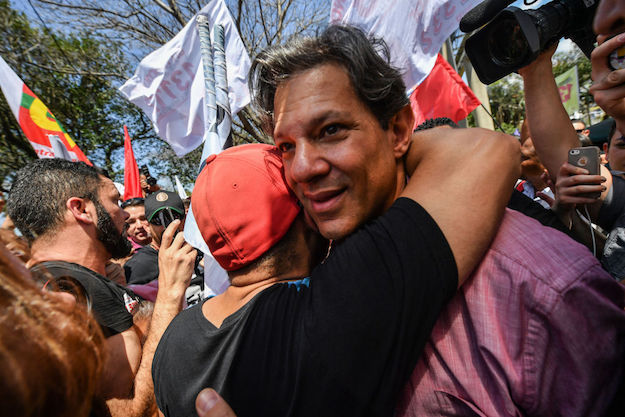
(Photo by Nelson ALMEIDA / AFP)
https://www.americasquarterly.org/content/brazil-2018-case-fernando-haddad
BY OLIVER STUENKEL | OCTOBER 1, 2018
If elected, Fernando Haddad has a chance to improve Brazil’s fortunes. But the odds will still be stacked against him.
Few mainstream commentators are optimistic about Brazil’s coming presidential election. In the run-up to the first round on Oct. 7, countless columnists and policymakers have expressed a mixture of resignation and despair at the near-certain prospect of a run-off between the far-right former army captain Jair Bolsonaro and the former Workers’ Party (PT) mayor of São Paulo, Fernando Haddad.
Neither has given Brazilians much to be hopeful for, or offered a coherent plan to move the country past its political and economic troubles. During an in-class debate about the elections last week, one of my students dryly noted that voters would have the choice between “terror and horror” in the run-off on Oct. 28.
Yet assuming that Bolsonaro and Haddad do indeed make the second round, what would be the best-case scenario for getting Brazil back on track? For starters, millions of Brazilians who dislike both candidates would have to hold their noses and side with the former São Paulo mayor.
Whoever wins will face significant obstacles in governing an angry and polarized country in need of major structural reforms. But Haddad stands the better chance of moving Brazil forward, mostly because Bolsonaro’s chances of gaining broad public support for difficult reforms are extremely small. Bolsonaro also lacks the personal skills and allies to manage Congress, and even the most basic understanding of public policy. More importantly, Bolsonaro’s divisive and authoritarian rhetoric – he recently said he would “accept no result other than victory”– poses a serious threat to Brazil’s democracy.
But the odds would be stacked against Haddad, too.
In the best-case scenario, Haddad would put together a team resembling that of former President Luiz Inácio Lula da Silva in 2002, with moderates in the Central Bank and the Ministry of Finance (such as Marcos Lisboa), and an activist foreign policy à la Celso Amorim. This strategy would require adopting a clear stance vis-à-vis Venezuela and Nicaragua – explicitly describing both as dictatorships – and recognizing that, particularly under Lula’s successor Dilma Rousseff, the PT mismanaged Brazil’s economy. He would need to show that the party is willing to learn from its mistakes.
This would involve a series of perilous political steps, requiring Haddad to resist Brazil’s trend toward polarization by occupying the ideological center. In a society where the political debate is organized along a pro-PT and anti-PT axis, such a strategy is fraught with risks. Most Bolsonaro voters will attack Haddad no matter what he does, and many PT stalwarts would accuse him of failing to defend the party’s principles – just like in 2002, when Lula’s pragmatism came at a tremendous political cost and led several long-term allies to leave the party.
Privately, Haddad may favor such a script. But structural obstacles abound. He would have to find ways to isolate powerful figures who disagree with a more moderate strategy, such as Gleisi Hoffman, the party’s president – perhaps by making her ambassador in Lisbon or Paris – without losing internal support in the party. As things stand, Hoffman is too powerful to be pushed out easily.
Finally, and most difficult of all, Haddad would have to find a way to address the giant elephant in the room – the fact that the party’s most powerful figure and Haddad’s mentor, Lula, is serving a multi-year prison sentence that the mainstream in his party considers to be illegal. Any move to free Brazil’s former president would complicate efforts to overcome polarization and focus on concrete needs – most urgently on issues like security and pension reform.








